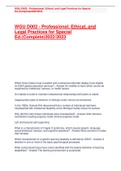Summary
Complete summary of the literature (articles) of the course 'Health and Living environment' - HSO-20306
- Course
- Institution
Best, Here is a complete and comprehensive summary of the literature belonging to the course 'Health and Living Environment' for the programme Health and Society at the WUR. (Period 2.2). This document contains 24 articles and provides a complete and comprehensive summary per article. The summari...
[Show more]












